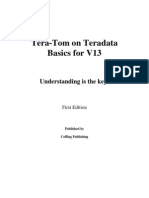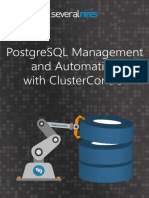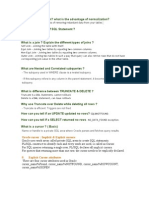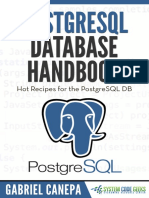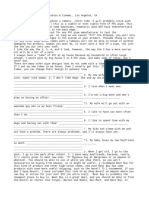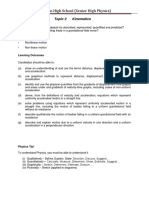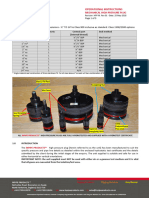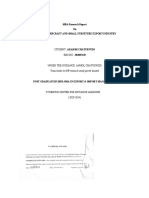PostgreSQL Cheat Sheet
PostgreSQL Cheat Sheet
Uploaded by
aaronpeacockCopyright:
Available Formats
PostgreSQL Cheat Sheet
PostgreSQL Cheat Sheet
Uploaded by
aaronpeacockOriginal Description:
Copyright
Available Formats
Share this document
Did you find this document useful?
Is this content inappropriate?
Copyright:
Available Formats
PostgreSQL Cheat Sheet
PostgreSQL Cheat Sheet
Uploaded by
aaronpeacockCopyright:
Available Formats
PostgreSQL CHEAT SHEET http://www.postgresqltutorial.
com
QUERYING DATA FROM A TABLE QUERYING FROM MULTIPLE TABLES USING SQL OPERATORS
SELECT c1, c2 FROM t; SELECT c1, c2 SELECT c1, c2 FROM t1
Query data in columns c1, c2 from a table FROM t1 UNION [ALL]
INNER JOIN t2 ON condition; SELECT c1, c2 FROM t2;
SELECT * FROM t; Inner join t1 and t2 Combine rows from two queries
Query all rows and columns from a table
SELECT c1, c2 SELECT c1, c2 FROM t1
SELECT c1, c2 FROM t FROM t1 INTERSECT
WHERE condition; LEFT JOIN t2 ON condition; SELECT c1, c2 FROM t2;
Query data and filter rows with a condition Left join t1 and t1 Return the intersection of two queries
SELECT DISTINCT c1 FROM t SELECT c1, c2
WHERE condition; FROM t1 SELECT c1, c2 FROM t1
Query distinct rows from a table RIGHT JOIN t2 ON condition; EXCEPT
Right join t1 and t2 SELECT c1, c2 FROM t2;
Subtract a result set from another result set
SELECT c1, c2 FROM t
ORDER BY c1 ASC [DESC]; SELECT c1, c2
Sort the result set in ascending or descending FROM t1 SELECT c1, c2 FROM t1
order FULL OUTER JOIN t2 ON condition; WHERE c1 [NOT] LIKE pattern;
Perform full outer join Query rows using pattern matching %, _
SELECT c1, c2 FROM t
ORDER BY c1 SELECT c1, c2
SELECT c1, c2 FROM t
LIMIT n OFFSET offset; FROM t1
WHERE c1 [NOT] IN value_list;
Skip offset of rows and return the next n rows CROSS JOIN t2;
Query rows in a list
Produce a Cartesian product of rows in tables
SELECT c1, aggregate(c2)
FROM t SELECT c1, c2 SELECT c1, c2 FROM t
GROUP BY c1; FROM t1, t2; WHERE c1 BETWEEN low AND high;
Group rows using an aggregate function Another way to perform cross join Query rows between two values
SELECT c1, aggregate(c2) SELECT c1, c2 SELECT c1, c2 FROM t
FROM t FROM t1 A WHERE c1 IS [NOT] NULL;
GROUP BY c1 INNER JOIN t2 B ON condition; Check if values in a table is NULL or not
HAVING condition; Join t1 to itself using INNER JOIN clause
Filter groups using HAVING clause
PostgreSQL CHEAT SHEET http://www.postgresqltutorial.com
MANAGING TABLES USING SQL CONSTRAINTS MODIFYING DATA
CREATE TABLE t ( CREATE TABLE t( INSERT INTO t(column_list)
id SERIAL PRIMARY KEY, c1 INT, c2 INT, c3 VARCHAR, VALUES(value_list);
name VARCHAR NOT NULL, PRIMARY KEY (c1,c2) Insert one row into a table
price NUMERIC(10,2) DEFAULT 0 );
); Set c1 and c2 as a primary key INSERT INTO t(column_list)
Create a new table with three columns
VALUES (value_list),
CREATE TABLE t1( (value_list), ….;
DROP TABLE t CASCADE; c1 SERIAL PRIMARY KEY, Insert multiple rows into a table
Delete the table from the database c2 INT,
FOREIGN KEY (c2) REFERENCES t2(c2) INSERT INTO t1(column_list)
); SELECT column_list
ALTER TABLE t ADD column; Set c2 column as a foreign key FROM t2;
Add a new column to the table
Insert rows from t2 into t1
CREATE TABLE t(
ALTER TABLE t DROP COLUMN c ; UPDATE t
c1 INT, c1 INT,
Drop column c from the table SET c1 = new_value;
UNIQUE(c2,c3)
); Update new value in the column c1 for all rows
ALTER TABLE t ADD constraint; Make the values in c1 and c2 unique
Add a constraint UPDATE t
CREATE TABLE t( SET c1 = new_value,
c1 INT, c2 INT, c2 = new_value
ALTER TABLE t DROP constraint; WHERE condition;
Drop a constraint CHECK(c1> 0 AND c1 >= c2)
); Update values in the column c1, c2 that match the
Ensure c1 > 0 and values in c1 >= c2 condition
ALTER TABLE t1 RENAME TO t2;
Rename a table from t1 to t2 DELETE FROM t;
CREATE TABLE t( Delete all data in a table
c1 SERIAL PRIMARY KEY,
ALTER TABLE t1 RENAME c1 TO c2 ; c2 VARCHAR NOT NULL
Rename column c1 to c2 ); DELETE FROM t
Set values in c2 column not NULL WHERE condition;
Delete subset of rows in a table
TRUNCATE TABLE t CASCADE;
Remove all data in a table
PostgreSQL CHEAT SHEET http://www.postgresqltutorial.com
MANAGING VIEWS MANAGING INDEXES MANAGING TRIGGERS
CREATE VIEW v(c1,c2) CREATE INDEX idx_name
CREATE OR MODIFY TRIGGER trigger_name
AS ON t(c1,c2);
WHEN EVENT
SELECT c1, c2 Create an index on c1 and c2 of the table t
ON table_name TRIGGER_TYPE
FROM t;
EXECUTE stored_procedure;
Create a new view that consists of c1 and c2
CREATE UNIQUE INDEX idx_name Create or modify a trigger
ON t(c3,c4);
CREATE VIEW v(c1,c2) Create a unique index on c3, c4 of the table t
WHEN
AS • BEFORE – invoke before the event occurs
SELECT c1, c2 • AFTER – invoke after the event occurs
FROM t; DROP INDEX idx_name;
WITH [CASCADED | LOCAL] CHECK OPTION; Drop an index
Create a new view with check option EVENT
• INSERT – invoke for INSERT
SQL AGGREGATE FUNCTIONS • UPDATE – invoke for UPDATE
CREATE RECURSIVE VIEW v • DELETE – invoke for DELETE
AS AVG returns the average of a list
select-statement -- anchor part
COUNT returns the number of elements of a list
UNION [ALL] TRIGGER_TYPE
select-statement; -- recursive part SUM returns the total of a list • FOR EACH ROW
Create a recursive view • FOR EACH STATEMENT
MAX returns the maximum value in a list
CREATE TEMPORARY VIEW v MIN returns the minimum value in a list CREATE TRIGGER before_insert_person
AS BEFORE INSERT
SELECT c1, c2 ON person FOR EACH ROW
FROM t; EXECUTE stored_procedure;
Create a temporary view Create a trigger invoked before a new row is
inserted into the person table
DROP VIEW view_name;
Delete a view DROP TRIGGER trigger_name;
Delete a specific trigger
You might also like
- PostgreSQL Database Administration Vol 1Document124 pagesPostgreSQL Database Administration Vol 1jose reyes100% (2)
- SAP Multiresource Scheduling - MasterDataDocument203 pagesSAP Multiresource Scheduling - MasterDatasrinigen425367% (3)
- PatroniDocument137 pagesPatronimarian moise100% (1)
- PostgreSQL Notes For ProfessionalsDocument73 pagesPostgreSQL Notes For ProfessionalsPeter RanieriNo ratings yet
- PostgreSQL On Amazon RDS - Amazon Relational Database Service PDFDocument72 pagesPostgreSQL On Amazon RDS - Amazon Relational Database Service PDFDanh NguyenNo ratings yet
- Postgresql InterviewQuestionDocument5 pagesPostgresql InterviewQuestionmontosh100% (1)
- The Internals of PostgreSQL - Chapter 1 Database Cluster, Databases, and TablesDocument10 pagesThe Internals of PostgreSQL - Chapter 1 Database Cluster, Databases, and TablesKevinNo ratings yet
- 205 Oracle To Postgres MigrationDocument58 pages205 Oracle To Postgres MigrationJerry Kelly100% (1)
- Mastering TeradataDocument564 pagesMastering TeradataLakshminarayana Sama50% (2)
- MongoDB Manual MasterDocument1,234 pagesMongoDB Manual MasterjemdmjsNo ratings yet
- SQ L Practice ProblemsDocument118 pagesSQ L Practice Problemsninh100% (7)
- 101 Oracle Tuning TipsDocument27 pages101 Oracle Tuning TipsDebasis Das100% (1)
- Mastering PostgreSQL 12 - Third Edition: Advanced techniques to build and administer scalable and reliable PostgreSQL database applications, 3rd EditionFrom EverandMastering PostgreSQL 12 - Third Edition: Advanced techniques to build and administer scalable and reliable PostgreSQL database applications, 3rd EditionNo ratings yet
- BMC Control-M 7: A Journey from Traditional Batch Scheduling to Workload AutomationFrom EverandBMC Control-M 7: A Journey from Traditional Batch Scheduling to Workload AutomationNo ratings yet
- Kisi-Kisi Tes Masuk Ppds Bedah Umum Fkui April 2011Document18 pagesKisi-Kisi Tes Masuk Ppds Bedah Umum Fkui April 2011David SantosoNo ratings yet
- PostgreSQL Cheat Sheet String FunctionsDocument1 pagePostgreSQL Cheat Sheet String FunctionsChris AslaNo ratings yet
- PostgreSQL For BeginnersDocument142 pagesPostgreSQL For BeginnersRubén Ruíz100% (4)
- Troubleshooting PostgreSQL - Sample ChapterDocument15 pagesTroubleshooting PostgreSQL - Sample ChapterPackt Publishing100% (1)
- Postgresql DBA ArchitectureDocument60 pagesPostgresql DBA ArchitectureRakesh DBA100% (1)
- Postgre SQLDocument35 pagesPostgre SQLSureshVitusNo ratings yet
- PostgreSQL Python TutorialDocument28 pagesPostgreSQL Python Tutorialdoguno7025No ratings yet
- Packt postgreSQL 9 6 High Performance 1784392979Document495 pagesPackt postgreSQL 9 6 High Performance 1784392979Caio Villela100% (4)
- Mastering PostgreSQL AdministrationDocument99 pagesMastering PostgreSQL AdministrationOleksiy Kovyrin100% (8)
- PostgreSQL Functions by ExampleDocument41 pagesPostgreSQL Functions by ExampleNguyễn Đăng HưngNo ratings yet
- PySpark Cheat Sheet PythonDocument1 pagePySpark Cheat Sheet PythonsreedharNo ratings yet
- SQL Server T-SQLDocument30 pagesSQL Server T-SQLAdrian Magpantay0% (1)
- 01 Become A PostgreSQL DBA Understanding The ArchitectureDocument10 pages01 Become A PostgreSQL DBA Understanding The ArchitectureStephen EfangeNo ratings yet
- Postgresql Management and Automation With ClustercontrolDocument42 pagesPostgresql Management and Automation With ClustercontrolYiannisZormpas50% (2)
- 15 Advanced PostgreSQL CommandsDocument11 pages15 Advanced PostgreSQL CommandsAbdulHakim Khalib HaliruNo ratings yet
- PostgreSQL Proficiency For Python PeopleDocument215 pagesPostgreSQL Proficiency For Python Peoplesatish_srgNo ratings yet
- Pganalyze - Best Practices For Optimizing Postgres Query PerformanceDocument26 pagesPganalyze - Best Practices For Optimizing Postgres Query PerformanceRamkumar100% (1)
- Running Production PostgreSQL Databases On Amazon RDS For PostgreSQLDocument42 pagesRunning Production PostgreSQL Databases On Amazon RDS For PostgreSQLTejasNo ratings yet
- Basic Informatica PowerCenter Case StudyDocument28 pagesBasic Informatica PowerCenter Case Studyetlbideveloper100% (1)
- The Magic of Tuning in PostgreSQLDocument15 pagesThe Magic of Tuning in PostgreSQLStephen EfangeNo ratings yet
- Administration PostgreSQLDocument109 pagesAdministration PostgreSQLAlmase50% (2)
- Research On AWS GlueDocument5 pagesResearch On AWS GlueJack Kenneth Bondoc-CutiongcoNo ratings yet
- PostgreSQL Notes For Professionals+Document72 pagesPostgreSQL Notes For Professionals+FranckONo ratings yet
- Mongo DBDocument6 pagesMongo DBctsasikumarNo ratings yet
- QuestionsDocument7 pagesQuestionsTarun SharmaNo ratings yet
- Oracle SQL Tuning - TipsDocument3 pagesOracle SQL Tuning - TipssvdonthaNo ratings yet
- CICS Mainframe DocumentDocument145 pagesCICS Mainframe Documentganip007No ratings yet
- MongoDB ReferenceCardsDocument28 pagesMongoDB ReferenceCardsimduserNo ratings yet
- PostgreSQL Developer's Guide - Sample ChapterDocument24 pagesPostgreSQL Developer's Guide - Sample ChapterPackt Publishing100% (1)
- Learning Practical SSISDocument70 pagesLearning Practical SSISRakeshNo ratings yet
- PostgreSQL CHEAT SHEETDocument8 pagesPostgreSQL CHEAT SHEETHarshNo ratings yet
- A Crash Course in MongoDBDocument40 pagesA Crash Course in MongoDBYamabushi100% (3)
- Apache Nifi Tutorial PDFDocument67 pagesApache Nifi Tutorial PDFMiguel Angel Lara RochaNo ratings yet
- PL SQL CheatsheetDocument3 pagesPL SQL CheatsheetAnuj Vikal100% (3)
- Kafka InternalsDocument30 pagesKafka InternalsDarshna GuptaNo ratings yet
- Monitoring PostgresqlDocument38 pagesMonitoring PostgresqlCharlesYanNo ratings yet
- How To Export Excel Files in A Python - Django Application - ASSIST Software RomaniaDocument13 pagesHow To Export Excel Files in A Python - Django Application - ASSIST Software RomaniaJorge Miguel Sánchez100% (1)
- Oracle Database Performance and Tuning Essentials 2016 PDFDocument29 pagesOracle Database Performance and Tuning Essentials 2016 PDFDarril ThomasNo ratings yet
- SQL Server Profiler: Step by Step GuideDocument11 pagesSQL Server Profiler: Step by Step GuidebiplobusaNo ratings yet
- MongoDB Aggregation Guide PDFDocument46 pagesMongoDB Aggregation Guide PDFDante LlimpeNo ratings yet
- PostgreSQL Database Handbook PDFDocument57 pagesPostgreSQL Database Handbook PDFRicardo Erro Franco100% (1)
- Mastering PL/SQL Through Illustrations: From Learning Fundamentals to Developing Efficient PL/SQL Blocks (English Edition)From EverandMastering PL/SQL Through Illustrations: From Learning Fundamentals to Developing Efficient PL/SQL Blocks (English Edition)No ratings yet
- PostgreSQL 15 Cookbook: 100+ expert solutions across scalability, performance optimization, essential commands, cloud provisioning, backup, and recoveryFrom EverandPostgreSQL 15 Cookbook: 100+ expert solutions across scalability, performance optimization, essential commands, cloud provisioning, backup, and recoveryNo ratings yet
- New-York, Monday, November 28, 1842.: Daily-No. 36 Park-RowDocument4 pagesNew-York, Monday, November 28, 1842.: Daily-No. 36 Park-RowSteban Macroth MacrothNo ratings yet
- 02 Bid Docs Caticlan Jetty Port Final W pcg-2 PDFDocument20 pages02 Bid Docs Caticlan Jetty Port Final W pcg-2 PDFKim GabaynoNo ratings yet
- HeartprintsDocument14 pagesHeartprintsDeesusuko KakayaninNo ratings yet
- Snodgrass, Anthony - Archaeology and The Emergence of Greece (2006)Document496 pagesSnodgrass, Anthony - Archaeology and The Emergence of Greece (2006)Emilio Meléndez GonzálezNo ratings yet
- SGSF 4th Edition InviteDocument11 pagesSGSF 4th Edition Invitesameelsaad1No ratings yet
- UnpublishedDocument10 pagesUnpublishedScribd Government DocsNo ratings yet
- Toolbox Meeting FORMDocument6 pagesToolbox Meeting FORMglenn dalesNo ratings yet
- Mariko Sorimachi Japanese Interpreter 09285218124 Dear Ma'am MarikoDocument2 pagesMariko Sorimachi Japanese Interpreter 09285218124 Dear Ma'am MarikoHenrietta LasudenNo ratings yet
- AIIMS PG Entrance May 2004 Solved Question Paper With KeyDocument15 pagesAIIMS PG Entrance May 2004 Solved Question Paper With KeySAIFNo ratings yet
- Analysis of Tractor Industry in IndiaDocument29 pagesAnalysis of Tractor Industry in IndiaRaju Rawat100% (1)
- Agilent AA Single and Multi-Element StandardsDocument5 pagesAgilent AA Single and Multi-Element StandardsAmir MohammedNo ratings yet
- Biodiesel From Seeds: An Experiment For Organic Chemistry: Steven W. GoldsteinDocument4 pagesBiodiesel From Seeds: An Experiment For Organic Chemistry: Steven W. GoldsteinnestorNo ratings yet
- Gym Excercises ExamplesDocument2 pagesGym Excercises ExamplesBlackRoseXSNo ratings yet
- Infant BathingDocument3 pagesInfant BathingPaul Mark Pilar100% (1)
- A Secret Place Lesson 1Document16 pagesA Secret Place Lesson 1YenThiLeNo ratings yet
- Power Cable Monitoring BrochureDocument8 pagesPower Cable Monitoring BrochureAhmed SalamaNo ratings yet
- 2024 Calendar Planner Philippines Excel 01Document24 pages2024 Calendar Planner Philippines Excel 01Na YumiNo ratings yet
- 57 - Abbrasive Blasting Check ListDocument3 pages57 - Abbrasive Blasting Check ListZeeshan AbbasiNo ratings yet
- Org and SW QualityDocument22 pagesOrg and SW QualityHarmonyBrennerNo ratings yet
- Thesis On Communication StrategyDocument4 pagesThesis On Communication Strategyafcmqldsw100% (2)
- Eci PDFDocument19 pagesEci PDFNatasha TylerNo ratings yet
- SOCI332 Extra Credit 2Document4 pagesSOCI332 Extra Credit 2exfakayNo ratings yet
- H2 Notes - Tutorial - KinematicsDocument43 pagesH2 Notes - Tutorial - KinematicsWee Chee LimNo ratings yet
- HPP Mechanical Rev 01 Operational Instructions 25.05.18Document3 pagesHPP Mechanical Rev 01 Operational Instructions 25.05.18tameem.p2023No ratings yet
- Akarsh Project ReportDocument54 pagesAkarsh Project ReportAkarsh ChaturvediNo ratings yet
- Administrative Law (LAW506) : Assignment 1Document5 pagesAdministrative Law (LAW506) : Assignment 1Amir Zahin AzhamNo ratings yet
- Mini CE Board SimulationDocument17 pagesMini CE Board SimulationRamjie JoveroNo ratings yet
- Spanner Selection for Metric and Imperial Hex BoltsDocument1 pageSpanner Selection for Metric and Imperial Hex Boltssaravanansha436No ratings yet








